Prologue: an important (meta) note about this series
I started this blog series 6 months ago - on June 11, 2024 - with one simple goal: to spread awareness about the Fediverse and introduce it to people not familiar with it. After less than a month of blogging about Mastodon I began stepping out of my comfort zone and exploring other projects, doing all kinds of interoperability tests.
I think it’s of paramount importance to describe where I am coming from, in order to frame any discussion of a new Fediverse project.
I am not a developer. I do not self-host (yet). I am simply a creative person - an independent writer, photographer and filmmaker - that discovered the Fediverse and thanks to it, found her voice again.
Mastodon is my main home on the Fediverse. From there, I have tried Pixelfed, Friendica, Fediverse content aggregators (Lemmy, Mbin and PieFed) and lately Sharkey. I have three federated Wordpress sites.
This is not meant to be a technical review of a Fediverse project that discusses all its features in great depth. This post is about JOY. The joy of having discovered a Fediverse software that I’ve been completely smitten with for over two months. It’s not perfect, but I enjoy using it. Since it’s a little obscure, I’d like to show you what it’s like.
thanks for being here,
Elena
Sharkey: beautiful inside and out
I lost track of how many times I heard that the Fediverse is unpopular because it has boring or stale product design... That it looks unfriendly and dated and passé - designed by engineers who had little regard for user experience.
Sure, some of this criticism could be valid (albeit harsh) when applied to Mastodon. Definitely Friendica. But there is a Fediverse microblogging platform that is absolutely gorgeous and full of brilliant design features that make using it a real pleasure. Its name is Sharkey, it’s a “soft fork” of Misskey – and it definitely deserves your attention.
What is the best way to describe Sharkey? Beautiful inside and out. Imagine: a powerful, decentralized platform powered by ActivityPub, with beautiful design and ease of use.
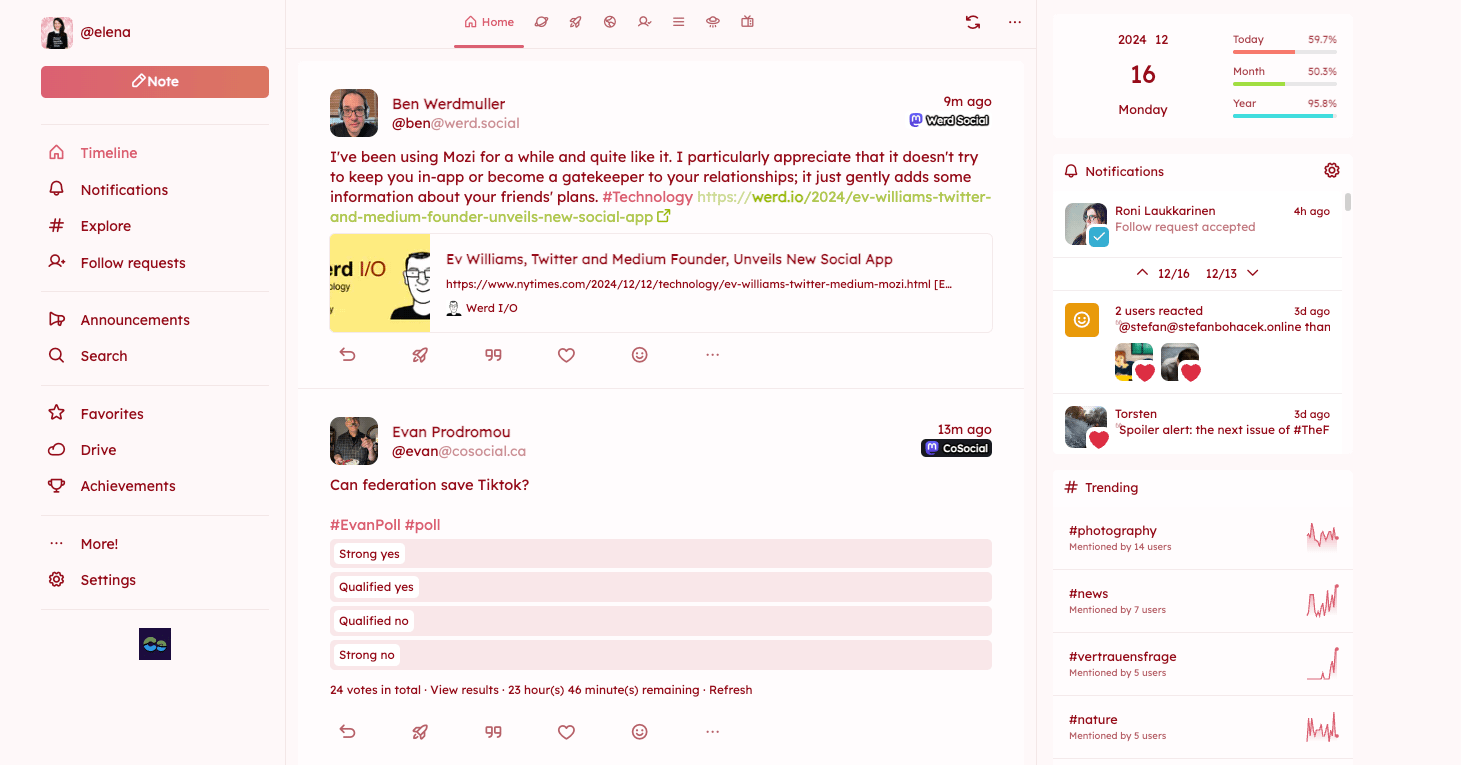
Sharkey in Numbers
How come you’ve never heard of Sharkey? According to FediDB, this software only has about 18,447 users – of them only 2,847 are monthly active users. By comparison, Mastodon has 7.6 MILLION total users and 850,000 monthly active users. The Sharkey server hosting my account – calckey.world – only has 54 monthly active users – in the whole world!
Origins: A word about Misskey
If you’ve been on the Fediverse for a while, you may not be familiar with Sharkey, but chances are, you have definitely heard about Misskey - a project from which it originates and from which Sharkey derives most of its brilliant features.
According to Wikipedia:
Misskey (Japanese: ミスキー, romanized: Misuki) is an open source, federated, social networking service created in 2014 by Japanese software engineer Eiji "syuilo" Shinoda. Misskey uses the ActivityPub protocol for federation, allowing users to interact between independent Misskey instances, and other ActivityPub compatible platforms. […] The name Misskey comes from the lyrics of Brain Diver, a song by the Japanese singer May’n.
It’s worth repeating that all the praise I bestow upon Sharkey should be directed at Misskey in primis and its creator Eiji "syuilo" Shinoda.
In an ideal world, this article would have been a show and tell of Misskey. But Misskey is my Everest: most of its instances are in Japanese, a language I don’t speak. This summer I started noticing high praise for Misskey forks, with Sharkey being frequently mentioned as a great project. And so I abandoned my original plans to join Misskey and opted for Sharkey instead.
During the process of writing this piece, I successfully signed up for an Italian Misskey instance – so maybe in the future I will cover that too.
What I like about Sharkey is that it takes the best from Misskey and improves on it, adding for example a Mastodon-compatible API, support for GDPR requests and enhanced moderation features for admins. Thus my Sharkey “show & tell.”
If you are interested in technical information about Misskey forks, this superb post by @pancakes@meow.company is for you:

My 3 favorite things about Sharkey
No.1: A beautiful, smart and easy onboarding process
I wish I could tell you how I selected calckey.world to be my Sharkey instance. This happened two months ago and I honestly do not remember how I stumbled upon it. Chances are, while looking up the most popular Sharkey servers on FediDB, the name calckey.world caught my attention, I clicked on its link and created an account. As simple as that.
Something that immediately impressed me what Sharkey’s onboarding process. It’s beautiful, easy to follow and really effective in explaining the software’s main features.
Mastodon often gets conflated with the whole Fediverse and the main criticism about them is that they are “too complicated” to join and difficult to understand. Conversely, platforms like Threads and Bluesky get high marks from regular people and journalists about their ease of use. Well, now you have an additional argument in the defense of the Fediverse - because Sharkey’s onboarding process is better than anything I have seen on the Fediverse OR by mainstream tech companies.
At the start of the Sharkey tutorial, a pop-up screen fades in and makes the interface - now in the background - completely blurry, allowing you to enjoy a full immersive experience of the tutorial.
What is ingenious is that Sharkey’s beautiful, easy-to-follow instructions make you advance through each step only if you complete the tasks you are learning about - like tagging photos with “sensitive” or using an advanced emoji reaction.
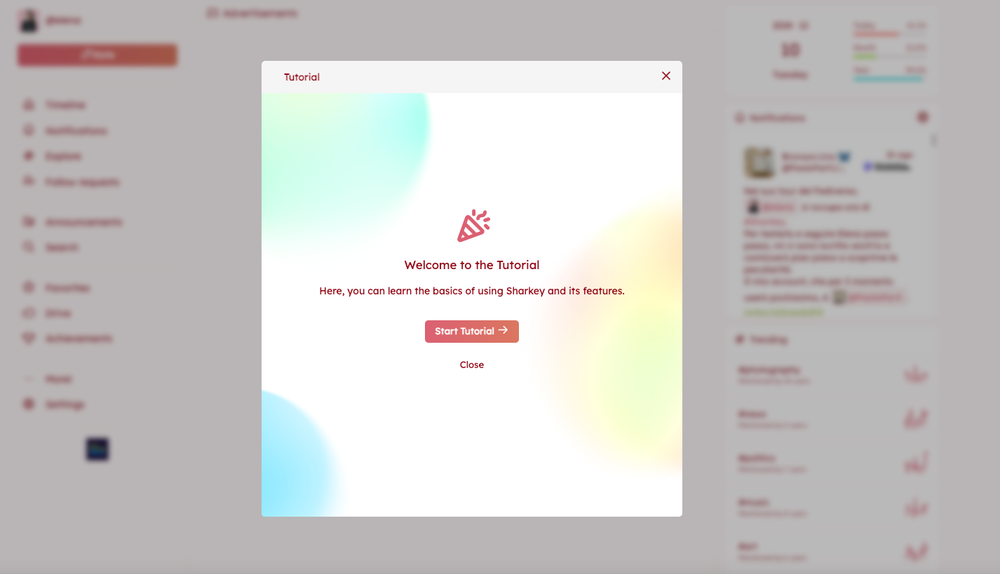
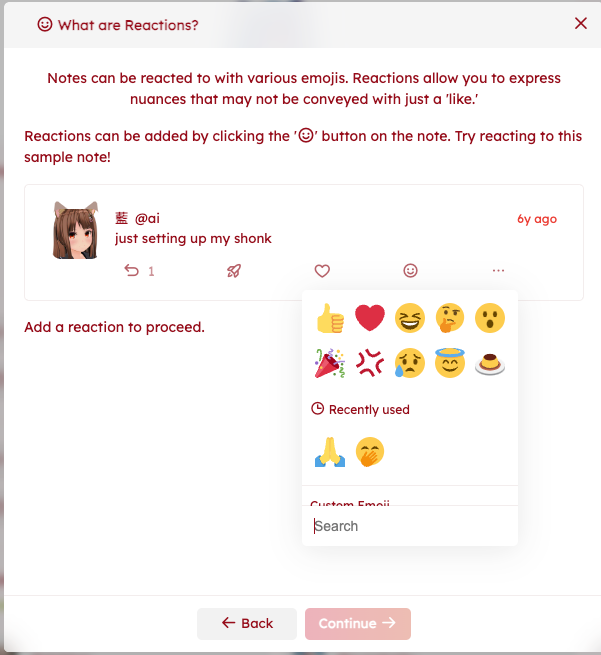
screenshots from the Sharkey tutorial: the welcome screen and a post explaining what are reactions
The onboarding process covers the following topics:
- a description about the type of “notes” (or posts on Sharkey) and what they are: original notes, replies, boosts, reactions and how to get advanced options through the menu
- reaction emojis
- timelines (home, local, social, bubble and global)
- post visibility and content warnings
- how to mark an attachment as “sensitive”
No.2: gorgeous, intelligent design
For me, what sets Sharkey apart from Mastodon, Friendica, Lemmy and other Fediverse projects I have been using is its beautiful design.
Sharkey features multiple themes: to select yours, you need to go to Settings -> Themes. I use the color scheme “Mi Cherry Light” – with a soft pastel pink background and cherry red text. But if you find this “too girl” you could opt for something like “Sushi light” with a mostly beige tint. Sharkey has 10 built-in themes to pick from and if you were so inclined, you could even create and upload your own theme. The platform is this versatile.
I also love its default font – Lexend – and how friendly and inviting it is. Everything feels soft and welcoming on Sharkey.
My favorite interface feature? How mentioned accounts show up in a different color, with the user's profile photo preceding their username. The server name is rendered in a lighter color compared to the username. Everything is set against a highlighted backdrop, which makes the mentioned account really stand out.

This is part of MFM – Markup language For Misskey (yes, major credit to Misskey, again) – and it includes a plethora of customizations:
- you can display specific parts of text as a URL
- you can add custom emojis
- you can make text bigger or smaller
- you can format content as a quote
- you can insert various animations
The full list of MFM features is available here:
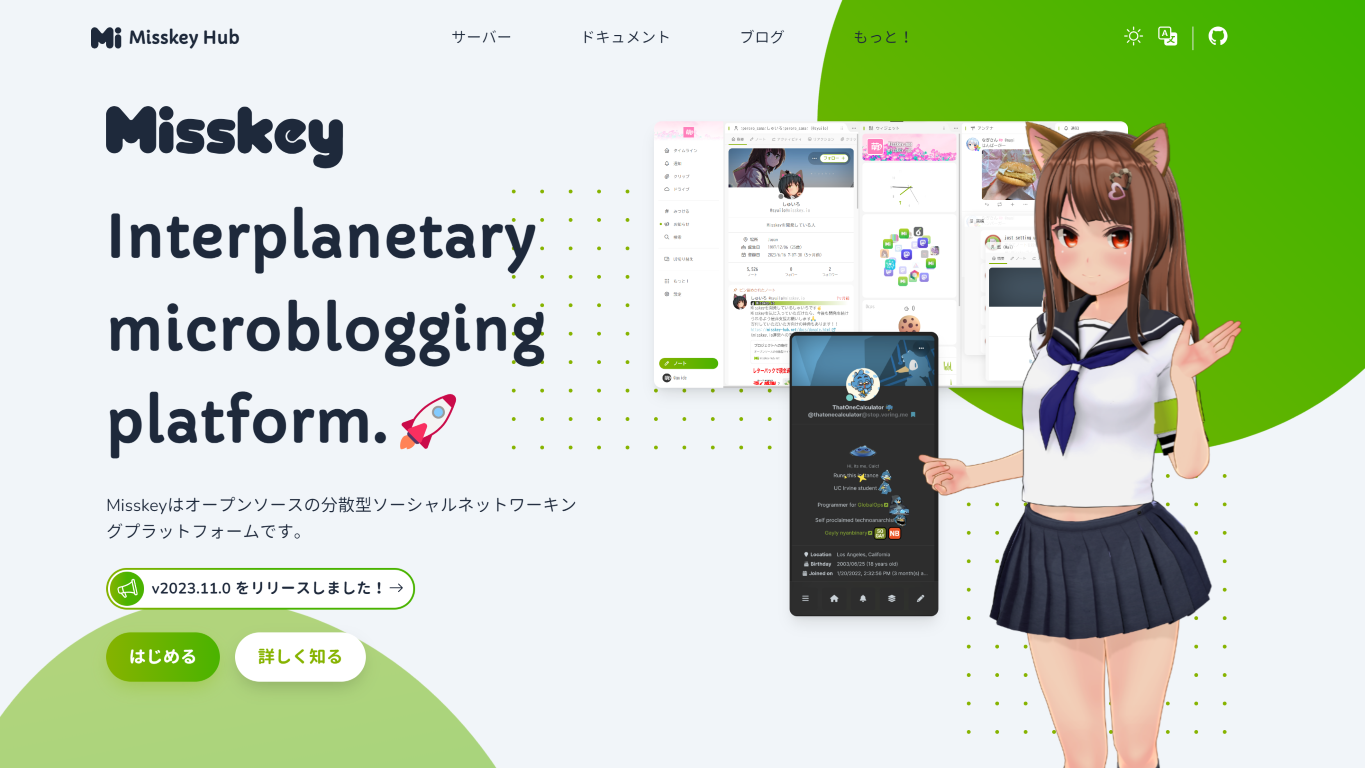
Sharkey subtly celebrates the myriad of independent servers and projects that make up the Fediverse. At the top of every note, under the timestamp (example: 2 min) there is a colorful label that tells you where the note originated from.
I especially love how independent servers are rendered.
For example, you can tell Ben Werdmuller posts from his own Mastodon instance called “Werd Social” - the name of his instance is preceded by the Mastodon logo and the name is set against a white backdrop.
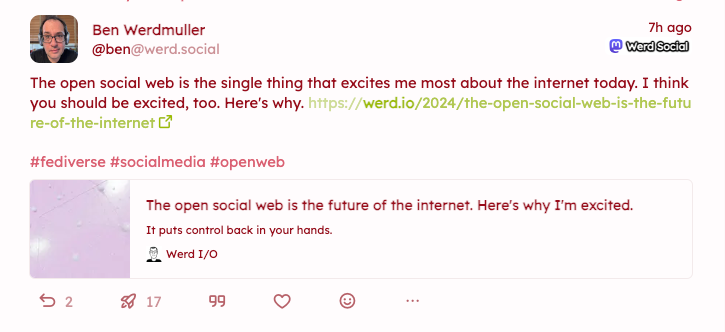
Stefan Bohacek’s posts come from “Stefan’s Personal Mastodon Server”:
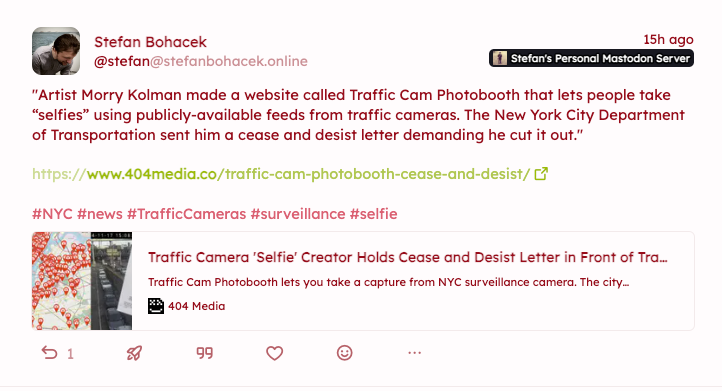
Mia Quagliarello’s federated Flipboard posts show up with this label:
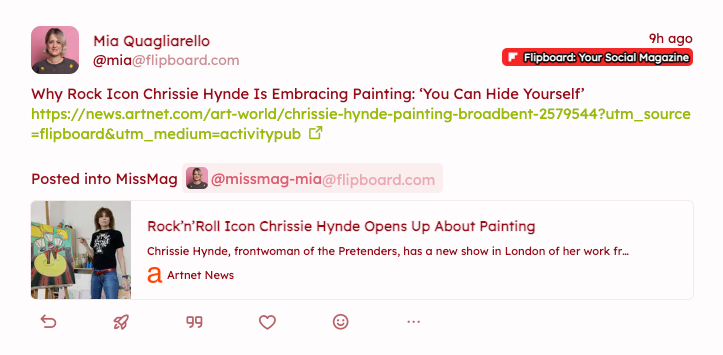
By contrast, this is how the very same post appears on Mastodon:

On Sharkey, a thin line connects threaded discussions – which makes reading threads so much easier. I would venture to say that this visual rendering of threaded posts far surpasses the experience of Twitter 1.0, Meta’s Threads, Bluesky and Mastodon.

No.3: Antennas
On Sharkey you can follow discussions via Antennas - aka advanced hashtags or topics.
Instead of following one simple hashtag - say #GhostIO (for discussions related to ghost.org) – I created an antenna and specified which keywords to listen to. I added: “GhostIO” OR “Ghost.org” OR “ActivityPug” (their fun way of describing their in-house ActivityPub efforts) and instructed the antenna to exclude the keyword “Halloween” (because there are lots of discussions about “ghosts” during that time of the year). Now, when I click on my “GhostIO” antenna, I see Fediverse discussions about the platform Ghost and its efforts to federate:
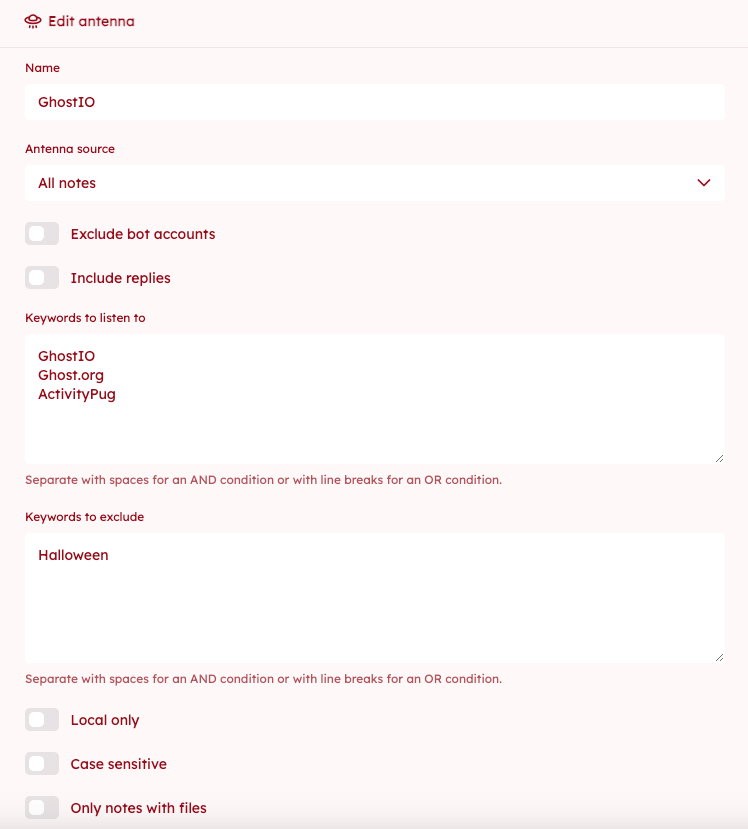
Just the tip of the iceberg
This is just the tip of the iceberg: a superficial overview of some of Sharkey’s features – but there is so much more to discover under the hood, if you were inclined to personalize your experience. For example, you could change the UI and display the main feed as a deck instead (similar to Tweetdeck - RIP):
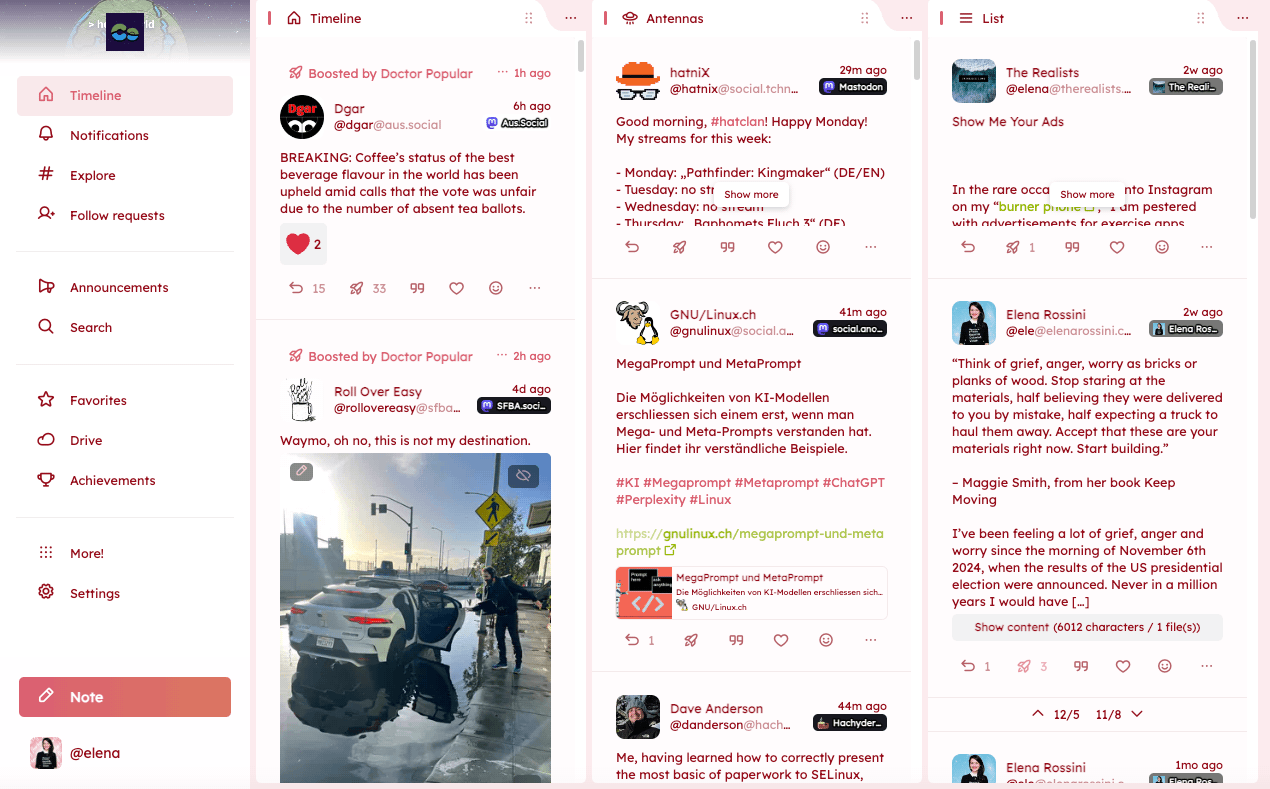
When you click on “Drive” you can see all the media you have ever uploaded to your Sharkey account:
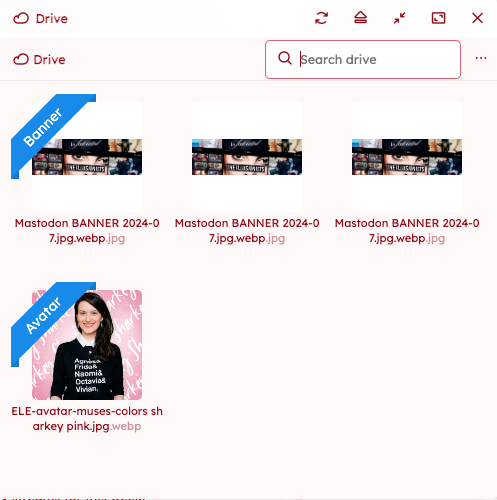
And there is so much more - games even!
Probably my favorite interface element – which originated in Misskey – is a widget in the top right corner of the screen that shows how much time has elapsed since the beginning of the day, month and year. Why do I like it so much? Because it constantly reminds me of the preciousness of time and how I should use it mindfully, making my use of Sharkey more intentional:
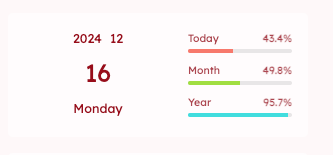
Mobile apps
Sharkey does have its own mobile iOS app: Aria. I'm not sure about an Android equivalent. But it's important to point out that the Sharkey website is fully responsive and renders really well on any device – iOS AND Android. I tested it on my Google Pixel and it works beautifully.
A word about sustainability
Over the course of the past two months, I have been tempted many many times to move over my Mastodon account to Sharkey. I like it so much, I would have loved to make it my main home on the Fediverse. Things is - realistically speaking - I am not 100% certain that Sharkey will be around in 5 or 10 years from now. And this is a scary thought.
Why the pessimism? Another very popular fork of Misskey – Firefish – has gone into maintenance mode and will reach end of support soon. The popular Fediverse content aggregator Kbin – maintained by only one developer – shut down a few months ago. Just this morning I found out that the popular app Mammoth and its instance moth.social and related subscription project sub.club will be shutting down at the end of January 2025.
Fediverse projects can be fragile, with no guarantees about their longevity. This is something that should always be top of mind when choosing a software or instance.
Sharkey is a fantastic software. If you are only used to exploring the Fediverse via Mastodon, you may be interested in giving it a try.
I found a good compromise: using Sharkey as a sort of alternate Fediverse account. I only follow a handful of people there and enjoy interacting with them thanks to a friendlier, more beautiful interface.
What’s interesting that I find myself more often on Sharkey than Mastodon these days. To keep the project thriving and sustainable, I am donating to it – and you should too, to the admin of whatever instance(s) you are on. This is the only way to ensure that any Fediverse project will survive and thrive.
My ideal social network
My explorations of the Fediverse so far made me realize that now I know what my ideal social network would be like: software powered by ActivityPub (duh!) with the functionalities of Friendica (Circles, importing RSS feeds, granular customizations) and the look and feel of Sharkey (especially Markup language For Misskey).
If some intrepid developer is reading this and thinks the two can be combined, let me know!
As always, thanks for being here.
Elena
Cover image credit: photo by Colton Jones on Unsplash
P.S.: If you want to catch up on all the previous posts for The Future is Federated, you can find them here:

💓 Did you enjoy this post? Share it with a friend!
👫 Follow me on Mastodon (my favorite network!) or Pixelfed. All my other links are available here: elena.social
📽️ If you'd like to support my work, you could buy or rent my documentary The Illusionists on the globalization of beauty. Watch the teaser:

💌 If you'd like to say hi, my contact information is here
✏️ If this post resonated with you, leave a comment!




